Snake plants are the ‘old reliable’ when it comes to houseplants. With over 90 species and hundreds of cultivars displaying beautiful growth forms and foliage patterns, snake plants are never dull. Learning to propagate snake plants from cuttings or divisions can provide more unique and easy-care plants for free.
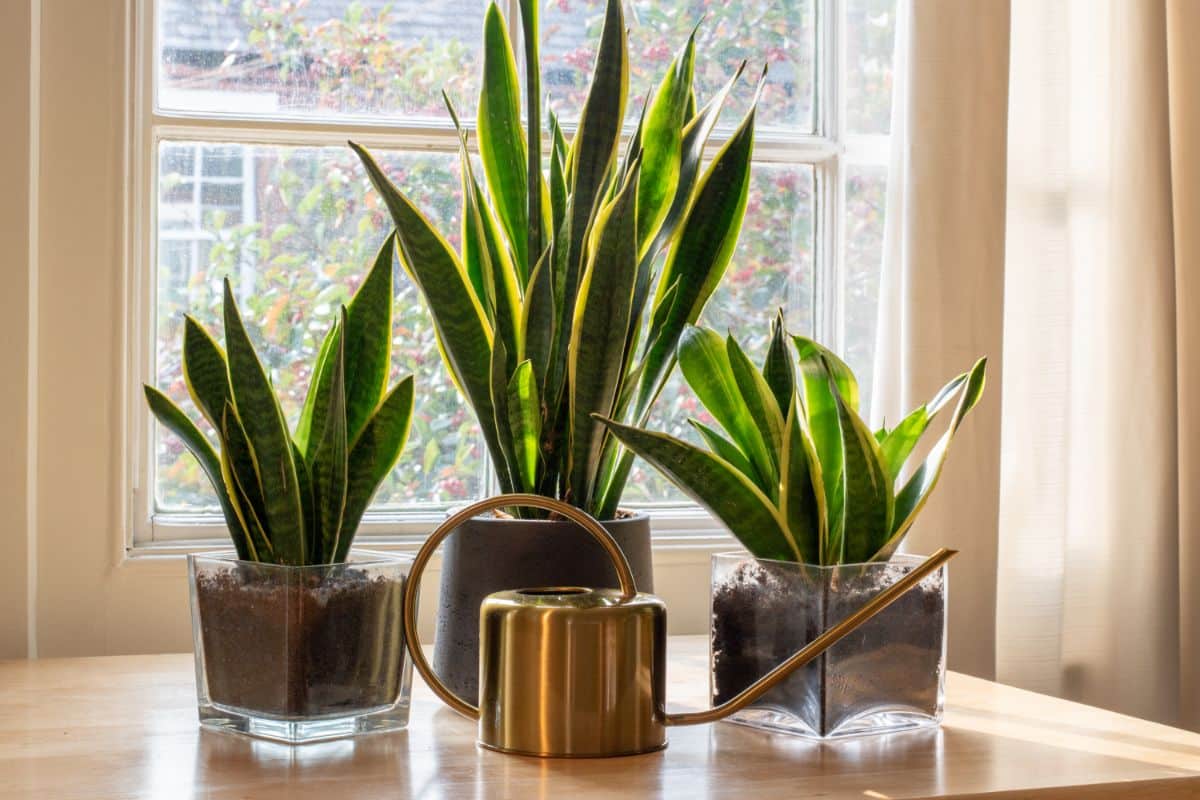
Snake plants are botanically known as Dracaena trifasciata. The botanical folks who classify plants renamed them from their former genus, Sansevieria. Such reclassifications are common in the plant world as we learn more about a particular species or genus.
Commonly, we refer to them as snake plants, sword-leaf plants, or mother-in-law’s tongue.
Jump to:
How To Grow Snake Plants From Cuttings
Snake plants can be grown from leaf cuttings. However, most will not come back true. We know vegetative propagation is usually the way to clone a new plant identical to the parent, but it doesn’t work that way with snake plants due to a trait called periclinial chimeral.
Cuttings from a leaf will likely revert to the plant’s non-mutated form, which is dark green. To reproduce a variegated snake plant identical to the parent and maintain its color patterns, propagate by root division and not leaf cuttings.
To Propagate Snake Plants from Cuttings in Water

Propagating snake plant leaves in water is about as simple as it gets, although you will need some patience.
- Select a healthy leaf. Look for a longer one, but it doesn’t need to be three feet. About 8-12 inches is fine. However, longer length leaves will work too. You just need a taller container to hold them. No need to cut them short; you can leave them full-sized.
- Trim the leaf off with sharp scissors or secateurs as near the base as possible.
- Place the leaf or leaves, if you are propagating more than one, in a narrow glass container that will hold it upright.
- Fill your container with clean, chlorine-free water. About the bottom quarter of the leaf should be submerged.
- Place the container in a warm spot out of direct sunlight. Change the water weekly.
In several weeks, roots should begin to form. Once your cutting has rooted well, transplant it to a potting mix and enjoy your new snake plant.
To Propagate Snake Plants from Cuttings in Soil
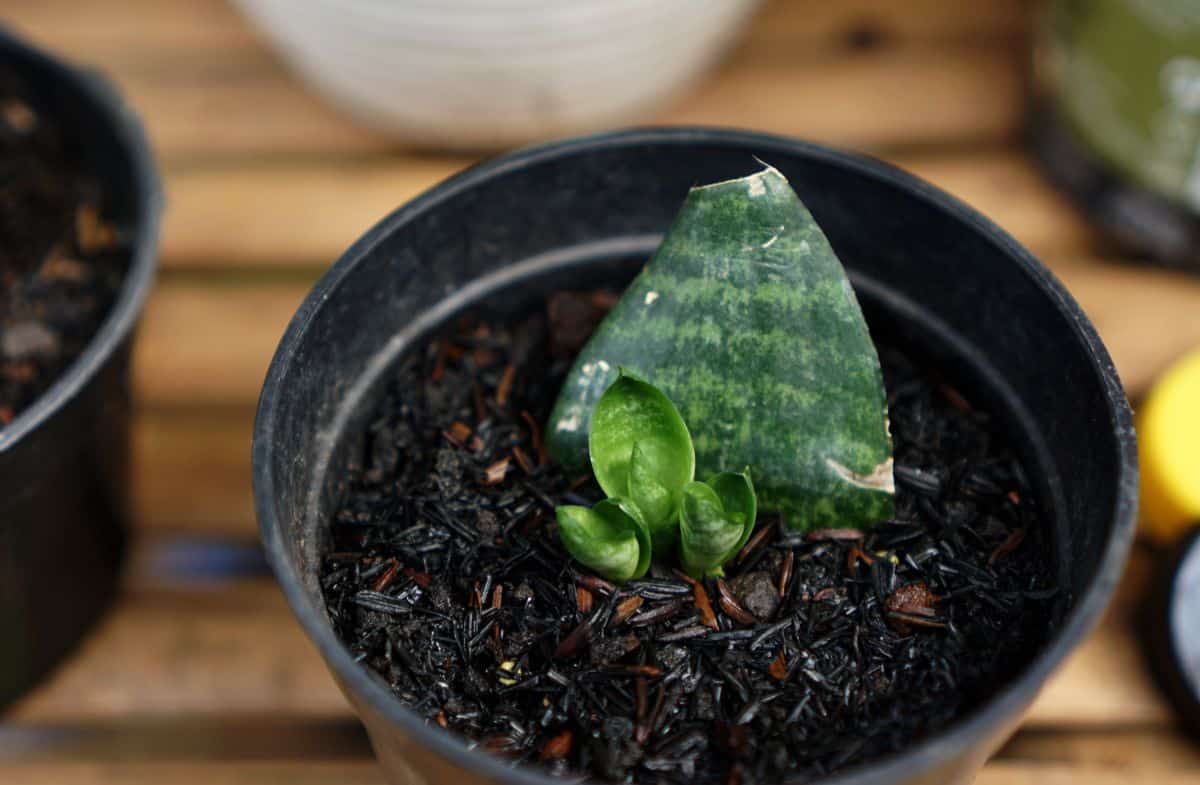
Propagating snake plant cuttings in the soil is similar to propagating in water, but you can make more than one cutting from a single leaf–if it is long enough. They also need to be allowed to dry a bit. Most importantly, and it sounds silly, don’t plant them upside down.
- Select a leaf and trim it off near the base as above.
- Cut the leaf into sections about 2-3 inches long. Use a marker or cut a notch in the bottom of each cutting so you remember which end was up. Once they are cut into pieces, it can be challenging to determine, and if planted upside down, they will not root.
- Allow the fresh cut ends to dry and callous over for a day or two. Snake plants are very susceptible to fungal and bacterial rots. Placing them in soil without callusing will likely cause the cut ends to rot instead of rooting.
- Prepare your tray or pot with suitable media. Cactus potting mix works well. Regular potting soil can be amended by adding perlite or vermiculite.

- ‘Stick’ or plant your leaf cuttings about an inch deep and firm up the soil. Water the soil so it is damp but not soggy.
Rooting hormone powder is not necessary, but if you have the urge, it won’t hurt.
- Place the container in a warm location out of direct sunlight. You can use a humidity dome or plastic bag to keep the soil slightly moist, but it is not strictly necessary. Snake plant cuttings that start to wrinkle and fold indicate they need more moisture.
- In several weeks, check the progress of your new snake plant’s roots by gently giving the stem a little tug. If they have not rooted and you accidentally pull them out, just replant them.
Once roots have been established, transplant them to larger containers and care for them as usual.
How to Propagate Snake Plants by Division
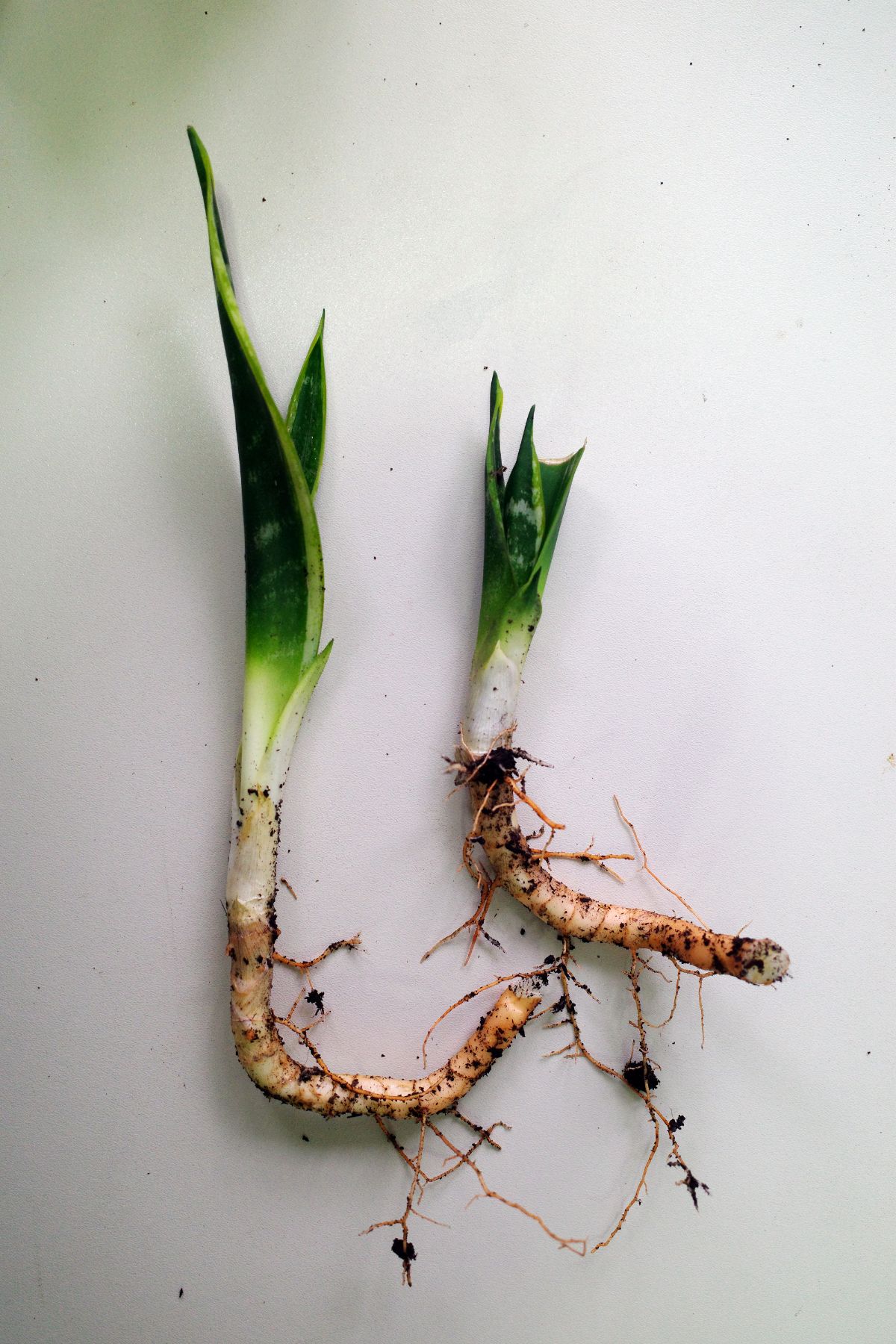
Super easy and fast, division is the only way to reliably reproduce those cool colors and variegations of some cultivars of D. trifasciata. Snake plants will have rhizomes that are pencil thick or bigger from which leaves sprout.
To Divide your Snake Plant:
- Remove your snake plant from its container.
- Using your hands, remove any loose soil around the roots. Don’t worry about getting it all. This step makes it easier to see what you have to work with.
- Gently pry the root ball apart and see if it wants to separate naturally. If so, that is the place to cut or break the rhizome. Otherwise, look for a place to cut the rhizome where a leaf, some fine roots, and a piece of rhizome can be kept together.
- Cut the rhizome with a knife or other tool.
- Repot each piece as a new plant. Each should have leaves, a section of rhizome, and some fine roots.
- Water in the new pots and enjoy.
Tips for Growing Snake Plants
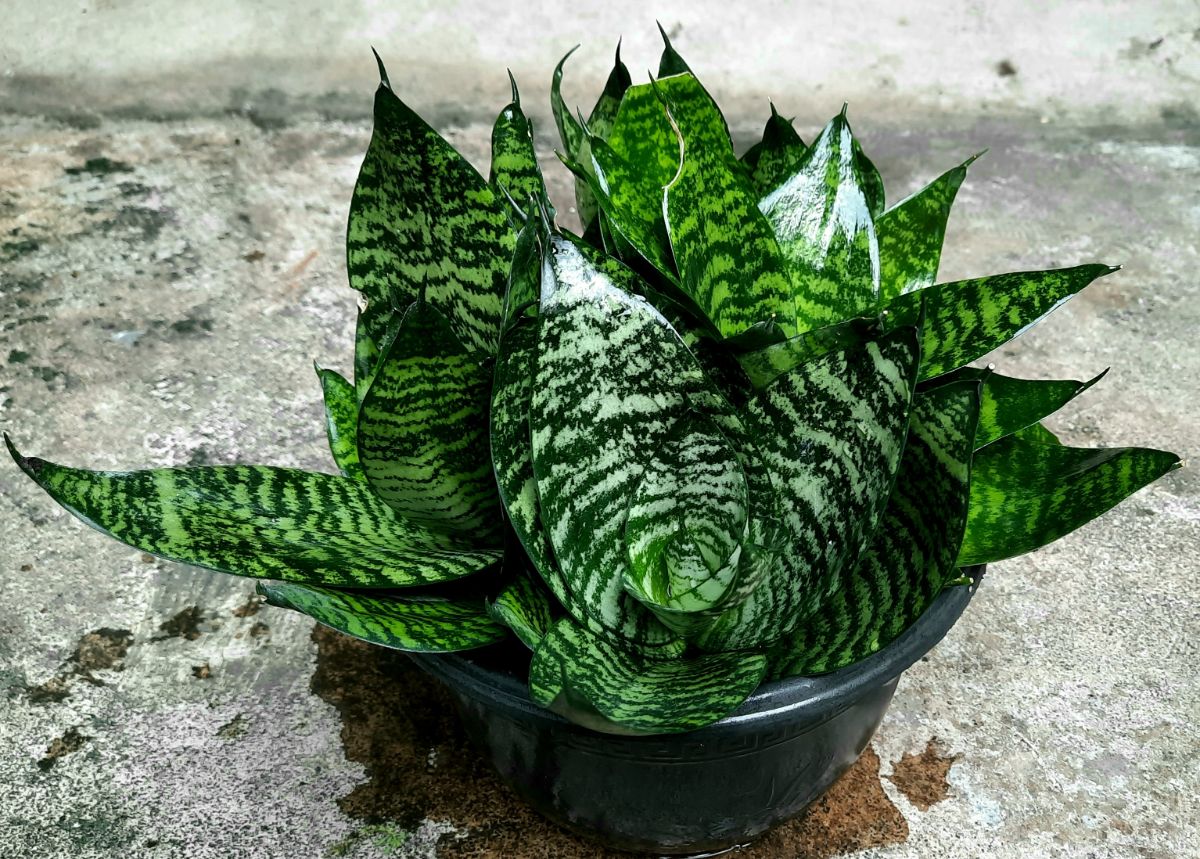
Snake plants are perfect for those of us who might occasionally, or more than occasionally, forget about our plants. They will tolerate less light than other plants and won’t mind if you forget to water them for a few weeks.
They don’t mind being a bit rootbound and won’t get mad if you fail to say hello (I’m looking at you, Ficus lyrata).
Pots and potting mix
The only requirement for pots and potting soil for your snake plant is that both have good drainage. Pots need adequate drainage holes in the bottom.
Even if there are holes, they may clog with a potting mix if there is a lot of peat, causing poor drainage even in what otherwise would be a well-draining pot.
Potting soil for cacti and succulents works fine, but a regular potting mix will work too. If using a general-purpose blend, add some perlite or cool-looking stones, lava rocks, or sand to help drainage.
Watering needs
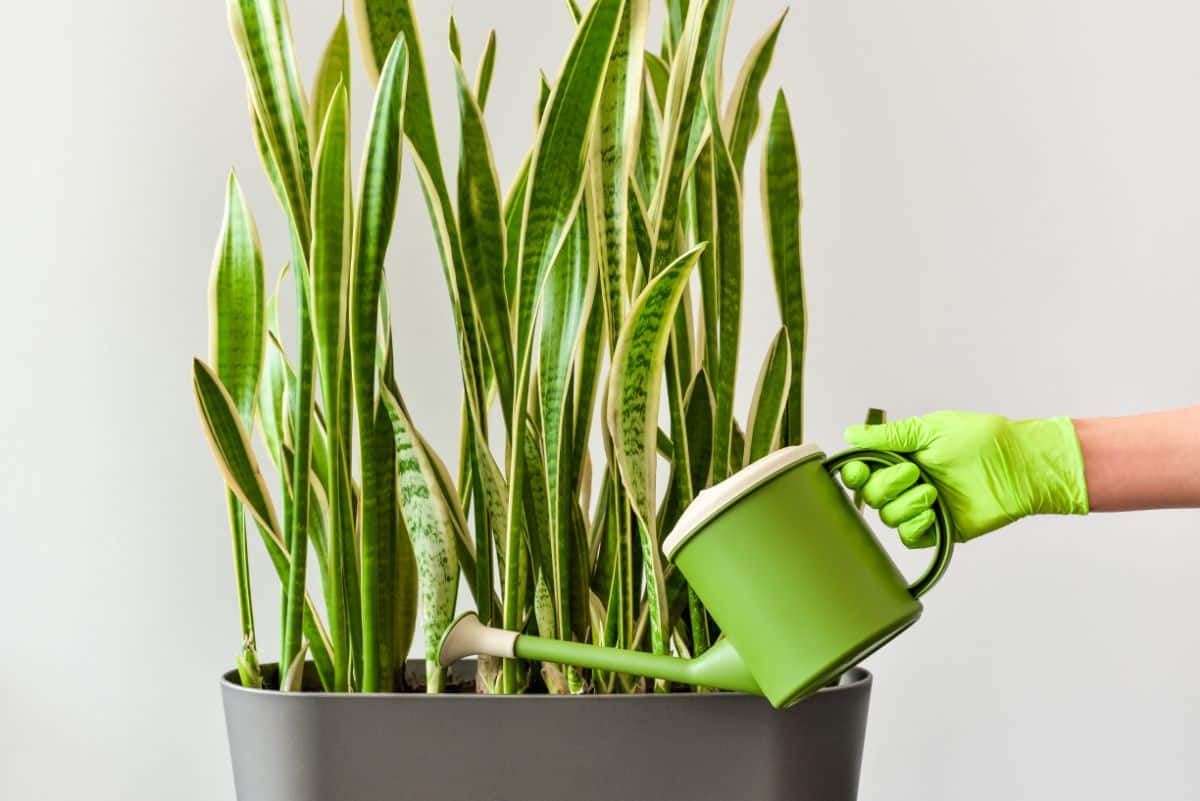
Overwatering is one of the most common ways to kill a houseplant. Followed by underwatering. For something so simple, it can cause heartache for a lot of plant parents.
Snake plants like their soil to dry between waterings. Test the soil an inch or two deep with your finger. If it is still damp or moist, wait a while before getting the watering can.
If your snake plant has started showing brown, dry leaf tips, it could be either underwatering or low humidity.
Light requirements for snake plants
Snake plants will tolerate the lower-intensity light found in the interior of your home, but that doesn’t mean they don’t need any light. Placing them under a skylight or near a window will make them grow more quickly and keep their colors bright.
If you’ve had your snake plant for a year and it hasn’t grown at all, try a brighter location. In their natural home, snake plants are found anywhere from almost full sun to moderate shade.
Fertilizer
Snake plants adapted to low-fertility soil, but a little fertilizer will help them grow more quickly at home. Feed them a slow-release fertilizer according to the instructions on the package. Once or twice a year should be sufficient.
You can also provide them with a half-strength liquid fertilizer once every month or two when you water. They don’t need much, so don’t overdo it.
Snake plants take some time to root from cuttings and a little effort to dig up and propagate by division, but the results are worth the time. And who doesn't want a few more easy-going houseplants? Grab your snake plant and give it a try.
Let us know your favorite variety in the comments below. We love a unique snake plant!









Leave a Reply